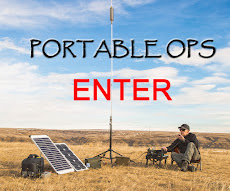Thursday, December 09, 2021
Manpack Communications System
Over the past couple of years I have operated my Yaesu FT-897D in a number of different ways, including operating from my mobile with a push up mast assembly populated with antennas, set up for field day with portable antennas, and on occasion while ice-fishing on frozen water. I recently began thinking about giving it a makeover turning it into a manpack communications system, that would also include the very efficient 10-60 meter vertical antenna that I built some time ago to be used with the FT-897D, the idea being that I could carry the complete assembly while hiking in to locations that required my equipment be not only portable but very transportable.
 Recently I gave some though as too how I could make this happen, and because I am familiar with the various type of packs used for back-packing, I realized that an external frame-pack could be the perfect way of combining the two together. Today, external frame-packs are not as prevalent as they once were years ago, as today's packs have internally included frames, and the external frame packs that I looked at all had something that I didn't like in regards to making the modifications required to turn one into a manpack communications system.
Recently I gave some though as too how I could make this happen, and because I am familiar with the various type of packs used for back-packing, I realized that an external frame-pack could be the perfect way of combining the two together. Today, external frame-packs are not as prevalent as they once were years ago, as today's packs have internally included frames, and the external frame packs that I looked at all had something that I didn't like in regards to making the modifications required to turn one into a manpack communications system.
 Upon arriving home, and with time spent in my shop, the first modification I needed to make was an aluminum arm that replaced one of the Cordoba straps that allowed the bottom shelf to fold upward against the vertical section of the frame. This modification was required so that the frame-work with included radios and antennas would stand up on its own when resting on the ground in the operating position. This was a simple conversion, as I utilized the same clevis pins with included split-rings that held the original Cordoba strap in place, to now hold the aluminum arm in place adding rigidity to the bottom base section. I also drilled a series of adjusting holes at one end of this arm, allowing for making adjustments for the antenna to stand straight when assembled and mounted in place.
Upon arriving home, and with time spent in my shop, the first modification I needed to make was an aluminum arm that replaced one of the Cordoba straps that allowed the bottom shelf to fold upward against the vertical section of the frame. This modification was required so that the frame-work with included radios and antennas would stand up on its own when resting on the ground in the operating position. This was a simple conversion, as I utilized the same clevis pins with included split-rings that held the original Cordoba strap in place, to now hold the aluminum arm in place adding rigidity to the bottom base section. I also drilled a series of adjusting holes at one end of this arm, allowing for making adjustments for the antenna to stand straight when assembled and mounted in place.
 The next modification that I made, was to remove and discard the upper tubular section that was formed U shaped and with adjusting holes drilled in either upright tube section, allowing for adjustments that might be required, depending on what type of load you might have fastened in place. With this U assembly removed, I then removed the plastic insert in the top right side vertical tube, and after taking measurements, I made up a new insert from aluminum that fit the internal diameter of the tube, and included the required sized hole in this aluminum adapter for the mounting stub located on the bottom of my 10-60 meter vertical antenna to fit.
The next modification that I made, was to remove and discard the upper tubular section that was formed U shaped and with adjusting holes drilled in either upright tube section, allowing for adjustments that might be required, depending on what type of load you might have fastened in place. With this U assembly removed, I then removed the plastic insert in the top right side vertical tube, and after taking measurements, I made up a new insert from aluminum that fit the internal diameter of the tube, and included the required sized hole in this aluminum adapter for the mounting stub located on the bottom of my 10-60 meter vertical antenna to fit.
With that done, I then took the measurements required to make up a mounting bracket for the Yaesu FT-897D. This low-profile bracket is also fabricated from hi-tensile aircraft aluminum allowing for the FT-897D to be solidly mounted to the pack frame. With everything temporarily assembled and no major issues to deal with, it was just a matter of assembling everything permanently.
 Now knowing that I couldn't head out over the hills without having other support equipment along, I turned my attention to how I could mount a small daypack behind the transceiver, and I found the perfect bag amongst my numerous photography gear bags, one that fit nicely behind the FT-897D and included the necessary rain-cover that could be put in place if required. I also found another rain-cover that nicely fit over the front panel of the FT-897D as well, keeping it out of the elements while hiking. Another small gear bag not real visible in the photos is located beneath the transceiver, and this is where the various antenna parts are stored until it is time to assemble the antenna. If required, I also have a rain-slicker that covers myself and the complete manpack if the weather turns for the worst.
Now knowing that I couldn't head out over the hills without having other support equipment along, I turned my attention to how I could mount a small daypack behind the transceiver, and I found the perfect bag amongst my numerous photography gear bags, one that fit nicely behind the FT-897D and included the necessary rain-cover that could be put in place if required. I also found another rain-cover that nicely fit over the front panel of the FT-897D as well, keeping it out of the elements while hiking. Another small gear bag not real visible in the photos is located beneath the transceiver, and this is where the various antenna parts are stored until it is time to assemble the antenna. If required, I also have a rain-slicker that covers myself and the complete manpack if the weather turns for the worst.
The fact that the FT-897D is an all-mode radio, I have an optional VHF/UHF antenna that may be mounted on the opposite tube to where my 10-60 meter antenna mounts. Also as you may have noted in the photo, I have a 5.11 tactical pouch fastened to one of the over the shoulder straps, allowing for my Kenwood TM-D72 to be carried, as it was during the time that I was out proofing the complete system on this day.
When its all said and done, I am very pleased with how everything has worked out, and I am enjoying operating my new manpack communications system.
On a final note, I have a few words to say about the Yaesu FT-897D with its rugged milspec build that places it in a league of its own, as there is no other all mode rig in todays amateur radio market-place that can offer you all the features that the FT-897D does. The fact that the FT-897D has the option of internal twin-pack 4500mAH batteries allowing for 20 watts out on HF, made this very efficient manpack communications system possible.
I have found that the most effective lower power setting that enables reliable portable HF communications is 20 to 30 watts, Try adjusting your 100 watt HF rig during down to 25 watts during a QSO and see who comments. Try the same with the power turned down to 10 watts or less, and watch the complaints about band conditions disappearing. Then adjust the power back up to 25 watts. I have done it enough times to know that 20 to 30 watts is the threshold where no difference would be reported from 100 watts of output power.
I know it will be a long time before I consider parting with this very fine transceiver that goes with me everywhere, especially in its present form as a manpack communications system.
NOTE.....all the photos expand.
My Website..... www.jerryclement.ca
 Recently I gave some though as too how I could make this happen, and because I am familiar with the various type of packs used for back-packing, I realized that an external frame-pack could be the perfect way of combining the two together. Today, external frame-packs are not as prevalent as they once were years ago, as today's packs have internally included frames, and the external frame packs that I looked at all had something that I didn't like in regards to making the modifications required to turn one into a manpack communications system.
Recently I gave some though as too how I could make this happen, and because I am familiar with the various type of packs used for back-packing, I realized that an external frame-pack could be the perfect way of combining the two together. Today, external frame-packs are not as prevalent as they once were years ago, as today's packs have internally included frames, and the external frame packs that I looked at all had something that I didn't like in regards to making the modifications required to turn one into a manpack communications system.
After looking on and off for months and even purchasing a external frame pack and bringing it home, I decided it would require too many modifications, and returned it to the store where I purchased it. Well recently that all changed when I happened to be walking through one of the local outdoor stores, and in particular where they have their packs on display. I noticed an external frame pack that caught my eye and I took the time to check it out. After scrutinizing it for a time, it looked promising enough for me to purchase it.
 Upon arriving home, and with time spent in my shop, the first modification I needed to make was an aluminum arm that replaced one of the Cordoba straps that allowed the bottom shelf to fold upward against the vertical section of the frame. This modification was required so that the frame-work with included radios and antennas would stand up on its own when resting on the ground in the operating position. This was a simple conversion, as I utilized the same clevis pins with included split-rings that held the original Cordoba strap in place, to now hold the aluminum arm in place adding rigidity to the bottom base section. I also drilled a series of adjusting holes at one end of this arm, allowing for making adjustments for the antenna to stand straight when assembled and mounted in place.
Upon arriving home, and with time spent in my shop, the first modification I needed to make was an aluminum arm that replaced one of the Cordoba straps that allowed the bottom shelf to fold upward against the vertical section of the frame. This modification was required so that the frame-work with included radios and antennas would stand up on its own when resting on the ground in the operating position. This was a simple conversion, as I utilized the same clevis pins with included split-rings that held the original Cordoba strap in place, to now hold the aluminum arm in place adding rigidity to the bottom base section. I also drilled a series of adjusting holes at one end of this arm, allowing for making adjustments for the antenna to stand straight when assembled and mounted in place. The next modification that I made, was to remove and discard the upper tubular section that was formed U shaped and with adjusting holes drilled in either upright tube section, allowing for adjustments that might be required, depending on what type of load you might have fastened in place. With this U assembly removed, I then removed the plastic insert in the top right side vertical tube, and after taking measurements, I made up a new insert from aluminum that fit the internal diameter of the tube, and included the required sized hole in this aluminum adapter for the mounting stub located on the bottom of my 10-60 meter vertical antenna to fit.
The next modification that I made, was to remove and discard the upper tubular section that was formed U shaped and with adjusting holes drilled in either upright tube section, allowing for adjustments that might be required, depending on what type of load you might have fastened in place. With this U assembly removed, I then removed the plastic insert in the top right side vertical tube, and after taking measurements, I made up a new insert from aluminum that fit the internal diameter of the tube, and included the required sized hole in this aluminum adapter for the mounting stub located on the bottom of my 10-60 meter vertical antenna to fit.With that done, I then took the measurements required to make up a mounting bracket for the Yaesu FT-897D. This low-profile bracket is also fabricated from hi-tensile aircraft aluminum allowing for the FT-897D to be solidly mounted to the pack frame. With everything temporarily assembled and no major issues to deal with, it was just a matter of assembling everything permanently.
 Now knowing that I couldn't head out over the hills without having other support equipment along, I turned my attention to how I could mount a small daypack behind the transceiver, and I found the perfect bag amongst my numerous photography gear bags, one that fit nicely behind the FT-897D and included the necessary rain-cover that could be put in place if required. I also found another rain-cover that nicely fit over the front panel of the FT-897D as well, keeping it out of the elements while hiking. Another small gear bag not real visible in the photos is located beneath the transceiver, and this is where the various antenna parts are stored until it is time to assemble the antenna. If required, I also have a rain-slicker that covers myself and the complete manpack if the weather turns for the worst.
Now knowing that I couldn't head out over the hills without having other support equipment along, I turned my attention to how I could mount a small daypack behind the transceiver, and I found the perfect bag amongst my numerous photography gear bags, one that fit nicely behind the FT-897D and included the necessary rain-cover that could be put in place if required. I also found another rain-cover that nicely fit over the front panel of the FT-897D as well, keeping it out of the elements while hiking. Another small gear bag not real visible in the photos is located beneath the transceiver, and this is where the various antenna parts are stored until it is time to assemble the antenna. If required, I also have a rain-slicker that covers myself and the complete manpack if the weather turns for the worst.The fact that the FT-897D is an all-mode radio, I have an optional VHF/UHF antenna that may be mounted on the opposite tube to where my 10-60 meter antenna mounts. Also as you may have noted in the photo, I have a 5.11 tactical pouch fastened to one of the over the shoulder straps, allowing for my Kenwood TM-D72 to be carried, as it was during the time that I was out proofing the complete system on this day.
When its all said and done, I am very pleased with how everything has worked out, and I am enjoying operating my new manpack communications system.
On a final note, I have a few words to say about the Yaesu FT-897D with its rugged milspec build that places it in a league of its own, as there is no other all mode rig in todays amateur radio market-place that can offer you all the features that the FT-897D does. The fact that the FT-897D has the option of internal twin-pack 4500mAH batteries allowing for 20 watts out on HF, made this very efficient manpack communications system possible.
I have found that the most effective lower power setting that enables reliable portable HF communications is 20 to 30 watts, Try adjusting your 100 watt HF rig during down to 25 watts during a QSO and see who comments. Try the same with the power turned down to 10 watts or less, and watch the complaints about band conditions disappearing. Then adjust the power back up to 25 watts. I have done it enough times to know that 20 to 30 watts is the threshold where no difference would be reported from 100 watts of output power.
I know it will be a long time before I consider parting with this very fine transceiver that goes with me everywhere, especially in its present form as a manpack communications system.
NOTE.....all the photos expand.
My Website..... www.jerryclement.ca



















No comments yet